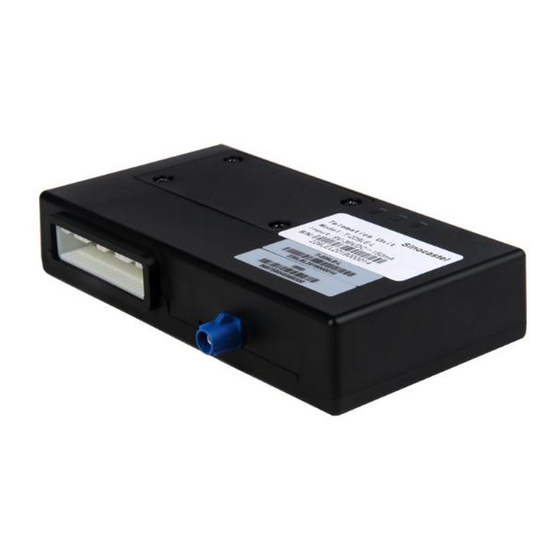
Advertisement
Quick Links
Advertisement

Summary of Contents for SinoCastel T-229LA-L
- Page 1 T-229LA-L User manual (Rev.1.0) Sinocastel Co., Ltd.
-
Page 2: Packing List
Product description The T-229LA-L terminal can provide passenger car and commercial vehicle customers with a variety of Telematics services including location, security, diagnosis, driving behavior analysis, on-board access points, etc., and can provide data accumulation for vehicle manufacturers and related supporting enterprises. At the same time, it can also meet the requirements of government departments for monitoring and remote emission monitoring of new energy vehicles. - Page 3 The vehicle-mounted OBD system can communicate with external devices that follow the same communication protocol through this interface. Micro USB interface Connect to the computer via USB cable. SIM card holder This interface is used to install the SIM card. Status indication Indication colour...
- Page 4 Setting parameters 3.1 PC Tool parameter setting Download the USB driver and PC Tool from http://www.sinocastel.com/Support/ and install it. Connect the USB setting cable to the terminal and the computer, open the OBD PC Tool, click "Help -> User Manual" and refer to the user manual to set the relevant parameters.
- Page 5 Install terminal 1. Before installing the terminal, make sure that the network parameters, working mode and other parameters are configured correctly; 2. When the vehicle is turned off, align the terminal with the OBD interface of the vehicle through the cable and insert it in place; 3.
- Page 6 *The terminal enters the dormant state after the flame is turned off, but the battery power is still consumed. The terminal dormant current is 5mA. In order to avoid battery loss, it is recommended to unplug the terminal before parking the vehicle for a long time (such as more than 5 days).
- Page 7 encryption. Every time the device logs in to the server, it will synchronize the AES key with the server. By default, encryption is disabled. 5.3 GPS report timing upload The terminal collects GPS data and uploads it according to the set collection time interval and the number of upload packages.
- Page 8 (3) Low battery voltage: 10.5 V (4) The coolant temperature is too high: 98℃ (5) Rapid acceleration: 0.4 g (6) Sudden braking: 0.6 g (7) Rapid lane change: 0.4g (8) Sharp turn: 0.5 g (9) Vibration: 1.5 g (10) Vibration: 0.08 g (11) Excessive engine idle time: 15 minutes (12) Fatigue driving: 240 minutes 5.8 Working mode...
- Page 9 The content of this manual is based on the "current situation". Shenzhen Aerospace Wireless Communication Technology Co., Ltd. does not provide any guarantee for the correctness, reliability or content of this manual. Shenzhen Aerospace Wireless Communication Technology Co., Ltd. reserves the right to revise or retract this manual at any time without notice. 7.
- Page 10 Shenzhen Aerospace Wireless Communication Technology Co., Ltd. implements a sustainable development strategy. Our company reserves the right to change or improve the above products without prior notice. Sinocastel Co., Ltd.or cancel the content of this document without prior notice. All rights reserved Sinocastel Co., Ltd.
- Page 11 and on, the user is encouraged to try to correct the interference by one or more of the following measures: -Reorient or relocate the receiving antenna. -Increase the separation between the equipment and receiver. -Connect the equipment into an outlet on a circuit different from that to which the receiver is connected.
Need help?
Do you have a question about the T-229LA-L and is the answer not in the manual?
Questions and answers